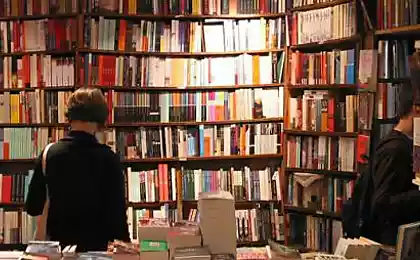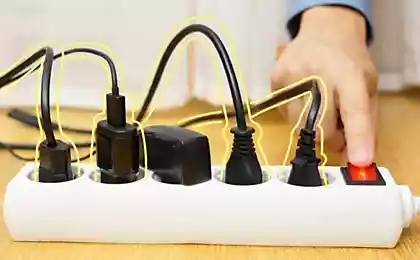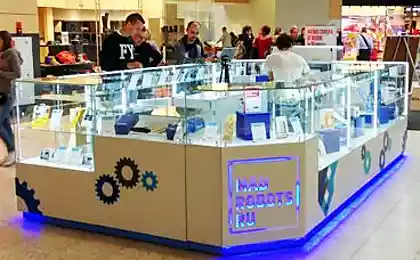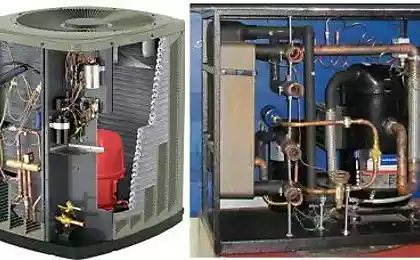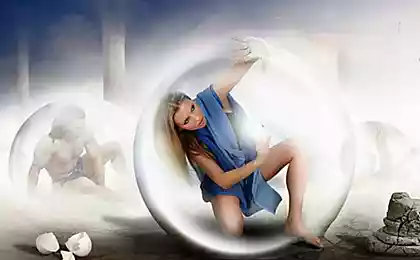972
Promising devices
For certain parts of the development companies have spent a lot of nerves and energy to the products listed below were published. But in spite of his genius, many of these devices failed miserably. Cinerama. Cinerama was the first wide-format projection. Screening of the film it is due to three synchronized 35mm projectors, which broadcast the image on a giant curved screen. Although the method was technically difficult, the visual result was overwhelming, and far superior to any technology of their time. Uh, we said "technically complex"? We had a view of the "virtually impossible." Projecting three films with perfect timing is as complex as it sounds, because there was no way to automate this process. For this work required projectionists of the highest class. Plus, very few cinemas were willing to make the necessary modifications costly. As a result, only a few dozen movies have ever been shown in this video format.
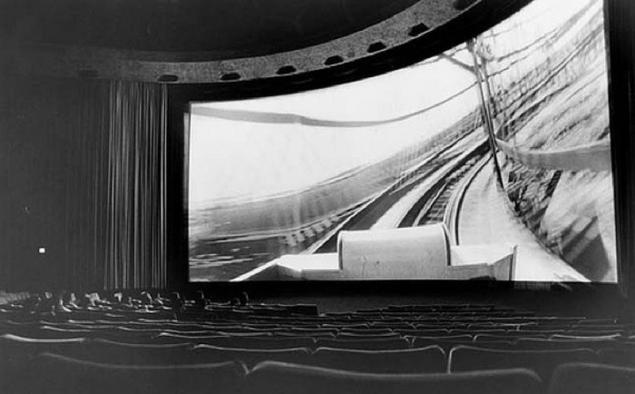
Intellevision. Intellivision by Mattel were home gaming console released in 1979. Its development was started only a year after the birth of her chief rival - Atari 2600. It was graphic and sound capabilities that are far ahead of Atari, but it was only the starting point of its innovations. Intellivision was the first 16-bit gaming system, the first to include the voice synthesizer, and in fact the first, to provide an opportunity to download games via cable. But poor marketing, coupled with poorly designed neergonomichnym controller led to the fact that Mattel has sold a total of three million units of the console. Would you say that this is a good idea? Losing Atari has sold ten times better. In 1983, the video game market experienced a crash, from which came only with the advent of Nintendo NES - system with all the innovation Mattel Intellivision, but without any of its lack.

Laserdisc. The first home digital video format was presented in 1978 - and it was Laserdisc, or «DiscoVision», as it were 70s. Having appeared on the market just two years after the video, this format offers high-density digital video and audio quality far beyond the capacity of any VCR. CDs, which until there were still four years, it was based on this technology. But, unfortunately, the wheels were heavy and easily broken, and the players for them were very loud compared to VCRs. They did not have the ability to record and discs and players are insanely expensive. And videocassettes seized power up to the appearance of DVD, which have been by and large a miniature version Laserdisc.

Betamax. This format from Sony offers a much smaller and strong video and a better resolution than the VHS format on their competitor JVC. Betamax even managed to surpass VHS to a year in the US and Japan. So what went wrong? "The war of formats" between Beta and VHS (ie, Sony and everyone else) became the technical descriptions. Perhaps the most likely factor in the failure of Sony Betamax was the reluctance to license its technology. JVC will not have such prejudices, and as a result, a wide range of manufacturers began producing VHS-devices at a much lower price. And Plus, Beta-devices can initially record a video of 60 minutes, compared to three hours in VHS. So VHS won.
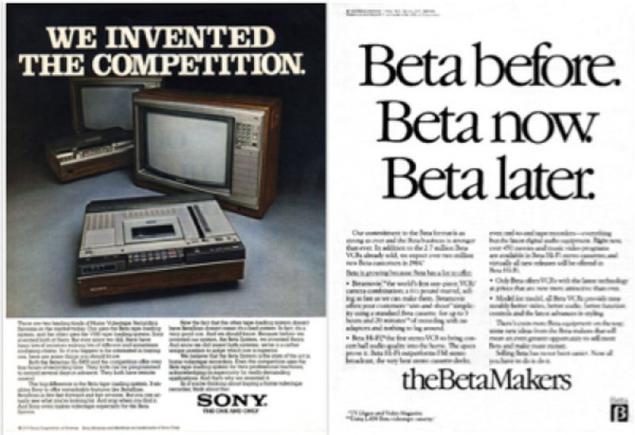
Quadraphonic sound. Quadraphonic sound made its debut in 1971, when several vinyl records with sound were released in different (and incompatible) formats. His goal was to play live sound simulation on PC Speaker. And if it is lost on the correct system is «3D-audio" gave a very impressive result. But the problem was that there was roughly a billion ways to give quadraphonic sound, and neither format has never been universally recognized. Dolby surround, which makes it about the same, has been standardized and razoshёlsya many times faster. Of course, the sound of Dolby surround is used mainly for theater and for listening to music the majority of people think that is enough and stereo.

QR codes. QR-codes, the name of which means "fast response" has been used for about ten years. They serve the same purpose as the bar codes, but contain much more information. They were originally designed to track the movements of parts in the production of cars, but their ability to quickly appreciated in the field of advertising. The problem was that no one knew what to do with them. A recent study showed that about 80 percent of American college students today do not have a clue what to do with QR-codes.

Digital audioplёnka (DAT). DAT were presented in 1987. It was a tiny cassette that recorded the sound of CD quality and higher, and were intended to replace the conventional foil tape. They were superior in all the traditional film were more durable and portable than even compact discs, and were able to record any sound segments. A failure as a DAT format for music sales occurred primarily because of piracy reasons. The music industry has realized that with the advent of high-quality rewritable media piracy rate will soar to the heavens - and buried the new technology. Interestingly, it paved the way for the all-digital formats like MP3, which, of course, is much easier piracy. Excellent work, the music industry!

Virtual reality. Already in the early 90's companies like «Virtuality» released arcade games like «Dactyl Nightmare», which puts you in a three-dimensional virtual space to perform different actions. However, the technology at the time was simply not enough advanced to realize the vision of science fiction, and attempts to create a true virtual reality was, to put it mildly, unconvincing. And even now that technology has come a huge way since the early 90s, we are still very far from making a full-fledged computer universe.
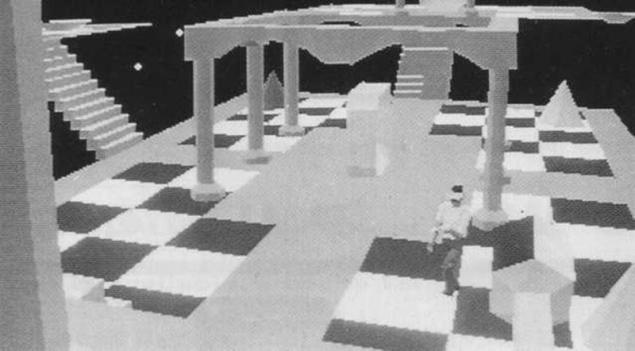
Apple Newton PDA. Long before Apple released its iPod, the era of its domination over the world of mobile devices, it has attempted to enter this market. Released in 1993, Apple Newton was actually the father of all handheld computers, and innovative device has been in almost all respects, but suffered a crushing fiasco. His problems began poorly defined, handwriting recognition and space price tag - and that's not taking into account the fact that he looked like the Commodore 64, crossed with a cassette recorder. Debut in 1995 as a tiny, cheaper and more functional Palm Pilot was the last nail in the coffin of his. Development of Newton was discontinued in 1998.
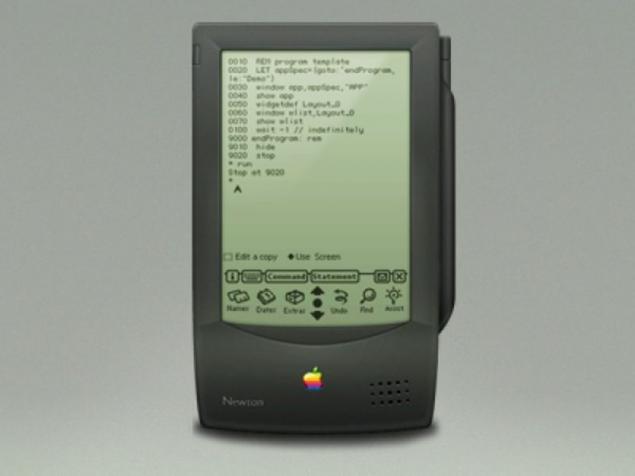
DIVX. In his first incarnation DIVX can safely assume that the biggest failure of all technological times. It was aimed at meeting the needs of those who wanted to "rent" movies in digital format - but the way that was chosen for this was a big mistake. Promoted electronic retailer Circuit City, the idea was simple enough. You take the rental disc, see him for two days and then discarded. Simple enough, right? Except for the fact that it was in fact a full-size DVD, but without all of its inherent characteristics, require a separate player that the customer had to buy, and the film distribution industry fought against him, knowing neither sleep nor rest. And then, like Netflix and Blockbuster have made digital film distribution really simple, DIVX long become a memory, having to its credit sales only in 1998 and 1999. His legacy lives only a few annoying and, in general, do not need the software, which is constantly trying to get you to download it for some unknown reasons.

Source: listverse.com

Intellevision. Intellivision by Mattel were home gaming console released in 1979. Its development was started only a year after the birth of her chief rival - Atari 2600. It was graphic and sound capabilities that are far ahead of Atari, but it was only the starting point of its innovations. Intellivision was the first 16-bit gaming system, the first to include the voice synthesizer, and in fact the first, to provide an opportunity to download games via cable. But poor marketing, coupled with poorly designed neergonomichnym controller led to the fact that Mattel has sold a total of three million units of the console. Would you say that this is a good idea? Losing Atari has sold ten times better. In 1983, the video game market experienced a crash, from which came only with the advent of Nintendo NES - system with all the innovation Mattel Intellivision, but without any of its lack.

Laserdisc. The first home digital video format was presented in 1978 - and it was Laserdisc, or «DiscoVision», as it were 70s. Having appeared on the market just two years after the video, this format offers high-density digital video and audio quality far beyond the capacity of any VCR. CDs, which until there were still four years, it was based on this technology. But, unfortunately, the wheels were heavy and easily broken, and the players for them were very loud compared to VCRs. They did not have the ability to record and discs and players are insanely expensive. And videocassettes seized power up to the appearance of DVD, which have been by and large a miniature version Laserdisc.

Betamax. This format from Sony offers a much smaller and strong video and a better resolution than the VHS format on their competitor JVC. Betamax even managed to surpass VHS to a year in the US and Japan. So what went wrong? "The war of formats" between Beta and VHS (ie, Sony and everyone else) became the technical descriptions. Perhaps the most likely factor in the failure of Sony Betamax was the reluctance to license its technology. JVC will not have such prejudices, and as a result, a wide range of manufacturers began producing VHS-devices at a much lower price. And Plus, Beta-devices can initially record a video of 60 minutes, compared to three hours in VHS. So VHS won.

Quadraphonic sound. Quadraphonic sound made its debut in 1971, when several vinyl records with sound were released in different (and incompatible) formats. His goal was to play live sound simulation on PC Speaker. And if it is lost on the correct system is «3D-audio" gave a very impressive result. But the problem was that there was roughly a billion ways to give quadraphonic sound, and neither format has never been universally recognized. Dolby surround, which makes it about the same, has been standardized and razoshёlsya many times faster. Of course, the sound of Dolby surround is used mainly for theater and for listening to music the majority of people think that is enough and stereo.

QR codes. QR-codes, the name of which means "fast response" has been used for about ten years. They serve the same purpose as the bar codes, but contain much more information. They were originally designed to track the movements of parts in the production of cars, but their ability to quickly appreciated in the field of advertising. The problem was that no one knew what to do with them. A recent study showed that about 80 percent of American college students today do not have a clue what to do with QR-codes.

Digital audioplёnka (DAT). DAT were presented in 1987. It was a tiny cassette that recorded the sound of CD quality and higher, and were intended to replace the conventional foil tape. They were superior in all the traditional film were more durable and portable than even compact discs, and were able to record any sound segments. A failure as a DAT format for music sales occurred primarily because of piracy reasons. The music industry has realized that with the advent of high-quality rewritable media piracy rate will soar to the heavens - and buried the new technology. Interestingly, it paved the way for the all-digital formats like MP3, which, of course, is much easier piracy. Excellent work, the music industry!

Virtual reality. Already in the early 90's companies like «Virtuality» released arcade games like «Dactyl Nightmare», which puts you in a three-dimensional virtual space to perform different actions. However, the technology at the time was simply not enough advanced to realize the vision of science fiction, and attempts to create a true virtual reality was, to put it mildly, unconvincing. And even now that technology has come a huge way since the early 90s, we are still very far from making a full-fledged computer universe.

Apple Newton PDA. Long before Apple released its iPod, the era of its domination over the world of mobile devices, it has attempted to enter this market. Released in 1993, Apple Newton was actually the father of all handheld computers, and innovative device has been in almost all respects, but suffered a crushing fiasco. His problems began poorly defined, handwriting recognition and space price tag - and that's not taking into account the fact that he looked like the Commodore 64, crossed with a cassette recorder. Debut in 1995 as a tiny, cheaper and more functional Palm Pilot was the last nail in the coffin of his. Development of Newton was discontinued in 1998.

DIVX. In his first incarnation DIVX can safely assume that the biggest failure of all technological times. It was aimed at meeting the needs of those who wanted to "rent" movies in digital format - but the way that was chosen for this was a big mistake. Promoted electronic retailer Circuit City, the idea was simple enough. You take the rental disc, see him for two days and then discarded. Simple enough, right? Except for the fact that it was in fact a full-size DVD, but without all of its inherent characteristics, require a separate player that the customer had to buy, and the film distribution industry fought against him, knowing neither sleep nor rest. And then, like Netflix and Blockbuster have made digital film distribution really simple, DIVX long become a memory, having to its credit sales only in 1998 and 1999. His legacy lives only a few annoying and, in general, do not need the software, which is constantly trying to get you to download it for some unknown reasons.

Source: listverse.com

